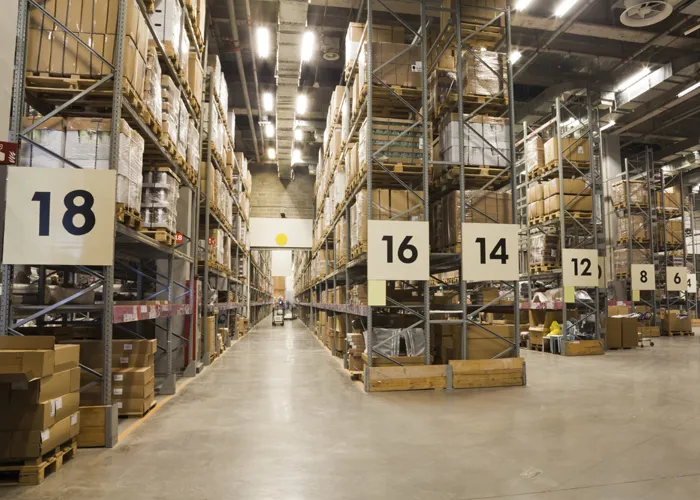
A warehouse is a building or structure used for the storage and handling of goods, products, or materials. It is typically a large, enclosed space with shelving, racking, or other storage systems designed to hold and organize inventory. Warehouses are used by a variety of businesses, including manufacturers, distributors, and retailers, to store and manage their products before they are shipped to customers.
Warehouses differ from other structures in several ways:
- Purpose: The primary purpose of a warehouse is to store and manage inventory, whereas other structures such as offices, homes, or shopping centers serve different purposes.
- Design: Warehouses are designed with functionality and efficiency in mind. They typically have open floor plans, high ceilings, and loading docks to facilitate the movement of goods. Other structures, such as offices or homes, are designed with comfort and aesthetics in mind.
- Size: Warehouses are generally larger than other structures, with some spanning hundreds of thousands of square feet. This is necessary to accommodate large quantities of inventory and equipment.
- Equipment: Warehouses are equipped with specialized equipment such as forklifts, pallet jacks, and conveyor systems to facilitate the movement and storage of goods. Other structures may not require such specialized equipment.
- Security: Warehouses often have advanced security systems to protect inventory from theft and damage. This includes features such as secure loading docks, cameras, and alarms. Other structures may not require such extensive security measures.
A warehouse is a large building specifically designed for the storage of goods, materials, or products. It plays a crucial role in the supply chain, acting as a hub for managing the flow of goods between manufacturers, distributors, and retailers.
Here are some key features of a warehouse:
- Large space: Warehouses are typically vast, open spaces to accommodate the storage of significant quantities of goods. They may also have designated areas for specific functions like receiving, shipping, packing, or quality control.
- Organized Storage: Goods within a warehouse are organized for efficient access and retrieval. This might involve shelving, racking systems, bins, pallets, or other storage solutions.
- Loading Docks: Warehouses typically have loading docks to facilitate the easy movement of goods in and out via trucks, containers, or other transportation methods.
- Inventory Management: Warehouses employ various systems and technologies to track the quantity and location of stored items. This ensures efficient inventory management and minimizes the risk of stockouts or inaccuracies.
- Controlled Environment: Some warehouses may have specific environmental controls like temperature, humidity, or pest control to protect sensitive goods from damage.
Depending on the type of goods stored and the specific needs of the business, warehouses can vary in design and operation. Some common types of warehouses include:
- Distribution Centers: These warehouses store finished goods and fulfill orders for retail stores, online customers, or other businesses.
- Manufacturing Warehouses: These warehouses store raw materials and finished products for manufacturing operations.
- Cold Storage Warehouses: These warehouses maintain controlled temperatures to store perishable goods like food or pharmaceuticals.
- Bonded Warehouses: These warehouses store goods under customs control before they are imported or exported.
Role in the Economy
Warehouses play a critical role in the economy by acting as the silent heroes of the supply chain. They bridge the gap between producers and consumers, ensuring the smooth flow of goods and contributing to several key economic aspects:
1. Efficiency and Cost Reduction:
- Economies of Scale: Warehouses allow bulk storage and consolidation of goods, reducing transportation costs by shipping larger quantities at once. This translates to cost savings for businesses and ultimately for consumers.
- Inventory Management: Efficient storage and tracking systems improve inventory management, minimizing the risk of stockouts and overstocking. This avoids lost sales and unnecessary production, optimizing resource allocation.
- Centralized Distribution: Strategic warehouse locations closer to markets can significantly reduce delivery times and transportation costs compared to shipping directly from production sites. This leads to faster customer fulfillment and potentially lower product prices.
2. Economic Growth and Job Creation:
- Supply Chain Management: Warehouses facilitate efficient supply chain management, ensuring businesses can meet customer demand reliably. This boosts economic activity and supports business growth and expansion.
- Logistics and infrastructure: The warehousing industry creates numerous job opportunities in logistics, transportation, storage, inventory management, and related fields. This contributes to overall employment and economic activity.
- Global trade: Warehouses play a crucial role in facilitating international trade by offering storage and distribution solutions for imported and exported goods. This supports global economic activity and interconnectedness.
3. Innovation and Technology:
- Automation and robotics: Warehouses are increasingly adopting automation and robotic technologies to improve efficiency, accuracy, and worker safety. This drives innovation in technology and automation solutions, benefiting various industries.
- Data and Analytics: Warehouse operations generate vast amounts of data on inventory levels, product movement, and customer demand patterns. This data can be analyzed to optimize supply chains, predict market trends, and develop new business strategies, contributing to overall economic intelligence.
In conclusion, warehouses play a multifaceted and indispensable role in the economy. They contribute to efficiency, cost reduction, economic growth, job creation, technological innovation, and even sustainability efforts. Their silent yet essential operations keep the wheels of the economy turning smoothly, ensuring the goods we rely on reach us when and where we need them.
